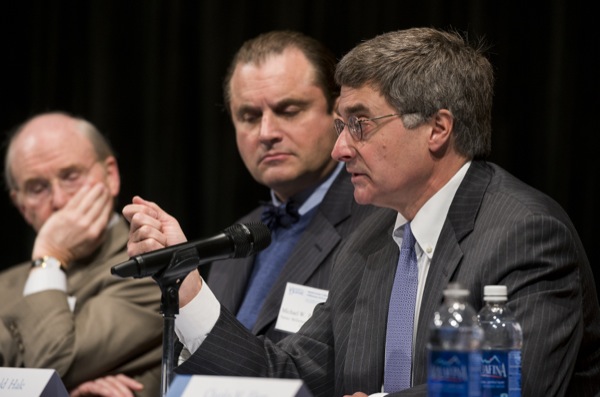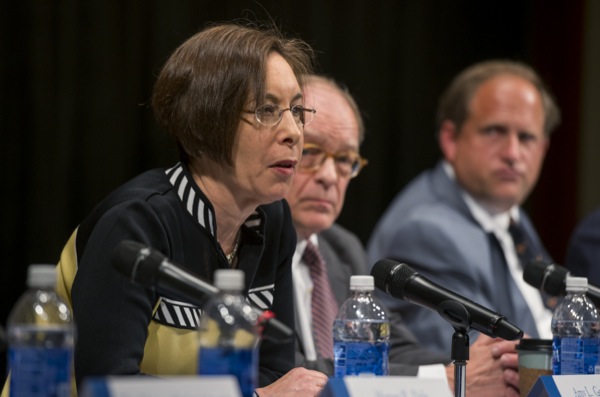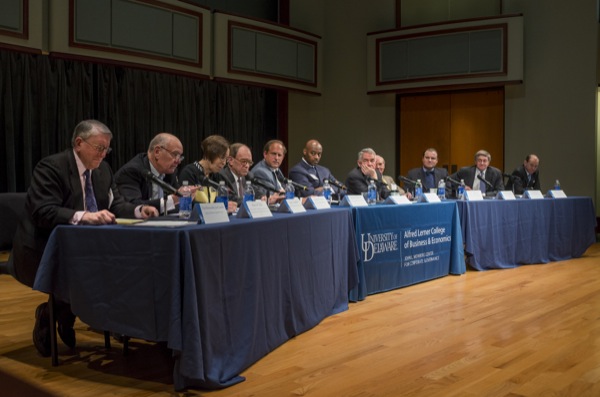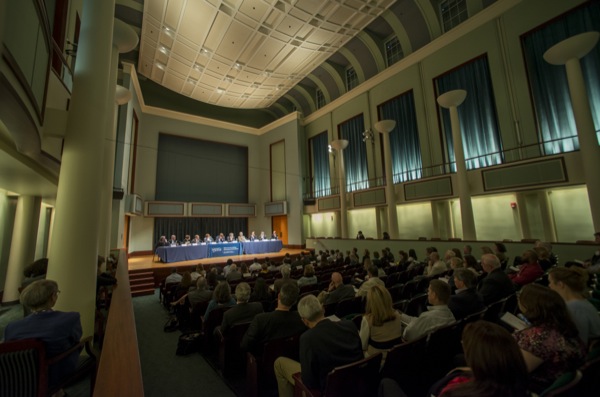

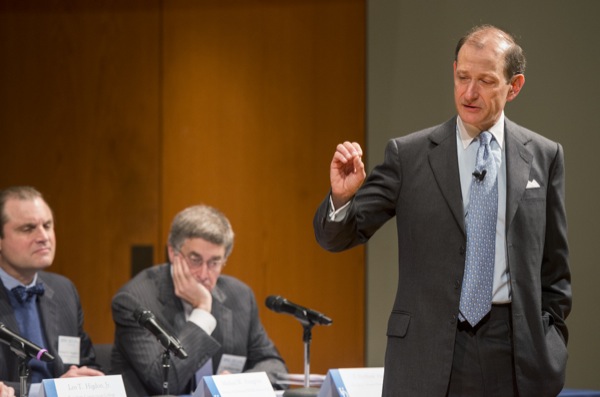
Transparent disclosure
Weinberg Center for Corporate Governance hosts panel on disclosure model
2:34 p.m., June 14, 2013--According to a powerhouse panel of nonprofit executives and corporate governance experts from the legal and academic communities, a model of disclosure created by Sheffield Hale, former chief counsel of the American Cancer Society, may be an innovative and effective way to increase transparency through better public disclosure when it comes to nonprofit governance, but the global adoption of such a model is unlikely.
Hosted by the John L. Weinberg Center for Corporate Governance at the University of Delaware in April, “Nonprofit Governance Best Practices,” featured panelists from the nonprofit, corporate, legal and academic communities, who examined Hale’s model as well as general best practice governance standards applicable to nonprofits.
Campus Stories
From graduates, faculty
Doctoral hooding
“As the American Cancer Society was rethinking their governance and moving from one model to another, Sheffield had the idea that transparency was critical,” said Charles M. Elson, Edgar S. Woolard Jr. Chair in Corporate Governance and director of the Weinberg Center, who moderated the panel. “If the beneficiaries and the donors understood better how the charity operated, not only would they be more comfortable with contributions to it, it would also create greater organizational discipline in the charity itself.”
While Hale’s model has been under discussion for a few years, Elson said the question now becomes whether it will be a viable model outside the organization that other nonprofits can or should follow.
Presenting the model
Hale emphasized the disclosure model is voluntary and does not attempt to impose a government mandate on charities.
“Instead I think this gives charities an opportunity to distinguish themselves and to prove their management,” said Hale.
For Hale, a high degree of underperformance and undermanagement in the nonprofit sector and limited accountability of management to the board and the board to the public might be rectified by transparency – the “best, cheapest, most effective way of increasing that level of accountability.”
Hale also found that many nonprofit board members are untrained regarding fiduciary obligations and aren’t aware of how they should monitor management. Part of that problem, he said, is lack of access to meaningful financial information and not knowing the right questions to ask.
“Watchdog groups have a difficult task because the sector is huge and the variety of nonprofits is just as large as the number that exist, so it’s hard to come up with ways of cross-sector analysis of effectiveness or efficiency,” said Hale. “So they resort to crude methods of analysis because there is no easy way to monitor or measure the effectiveness of a nonprofit.”
Consider a university and a public charity. You can’t compare the two, said Hale, because they raise money differently and they have different missions.
“The very act of having to articulate publicly your mission, how you hope to achieve it and how you believe you’ve met it or not met it is powerful,” said Hale. “Equally powerful is for charities to be able to say they have not met something.”
According to Hale, such an admission shows credibility and maturity as an organization, displays the ability to make adjustments and publicly acknowledge its accountability.
It’s as simple as high school math, Hale concluded.
“In high school the math teacher always said ‘show your work,’” said Hale. “To me, that’s what nonprofits are not doing. They need to tell the public how they’re accomplishing things and how they’re not. It’s a powerful sales tool and a powerful management tool and it’s where the dialogue begins.”
Panelists engage in debate
One panelist said he was thrilled with Hale’s model because transparency is a proactive effort and reflects the shift in the nonprofit sector toward large, national organizations among citizens and donors.
According to the panelist, who offered a perspective from large charities, Hale’s proposal is an innovative and effective way to inform external sources who do not understand the role of large, sophisticated charity organizations while telling internal governing boards and management about the critical aspects of corporate governance and how corporate governance needs to adjust to a higher level of sophistication.
The panelist stated that there is an expansion of the nonprofit sectors in large, multi-state national organizations, which can be seen in the social services and health care. At the same time, as these large, charitable organizations expand the question is whether their governance, in the management sensitivity governance, has changed and matured at the same time.
Elson noted that the focus in governance has long been on the for-profit side and called nonprofit governance “the new frontier.”
“Nonprofits are huge organizations and the governance has really been in question,” said Elson. “This was evident in the scandals over the last couple years like the reorganization of American Red Cross, issues at American University, even at the Smithsonian. This is an area that is really fertile for change and debate and that’s what the Weinberg Center is all about.”
Bringing a for-profit board member perspective, Leo I. Higdon Jr., president of Connecticut College, said the issue is really about performance and accountability.
“Nonprofits fulfill an important role,” said Higdon. “There has never been a more difficult, more challenging and complex environment than we have now. The pace of change is accelerating and anyone heading a nonprofit is looking at their organizational model, how they deliver value and how they adhere to their mission. That elevates the importance of the board.”
Higdon agreed that maintaining awareness of organizational context is important and noted that nonprofits could benefit beyond Hale’s suggestions by considering things like selection of trustees or the types of information presented to boards among other considerations that accompany this notion around transparency and disclosure.
“If we’re focused on accountability, results and performance, I think the issue of disclosure fits into the larger tapestry of culture change and also means culture change for the institution in how it operates, manages itself and its own sense of accountability,” said Higdon.
David P. Roselle, director of Winterthur Museum, Garden and Library, and president emeritus of UD, noted that for-profits and nonprofits alike still have audiences to report to.
“In the profit world if you’re running an organization you have shareholders,” said Roselle. “In the not-for-profit world, perhaps a university, you have stakeholders like students, parents, faculty, staff, football fans, and on and on. In truth, I think the stakeholders are harder to manage than shareholders.”
Roselle also spoke to the growing number of government forms surrounding nonprofit governance, like IRS Form 990, used for nonprofit reporting, and IRS Form 13909, a confidential reporting form if one suspects fraud by a nonprofit, as well as things like PILOTS, or payments in lieu of taxes.
“All these things need oversight and there will be more and more going forward,” said Roselle.
From a trustee perspective, Raymond J. McGuire noted that in his 20-year experience, he has seen more local nonprofits that are performing well, with involved and well-intentioned boards.
“I want to make certain we don’t indict the entire industry because there are an exponential number of things that are working well,” said McGuire, who is head of Global Banking at Citigroup Inc. “That being said, certain principles should apply and they should take into account the context and size of the organizations.”
McGuire emphasized that the rules outlined by Hale should be considered best practices but because of the varied nature of nonprofits, cannot be applied uniformly.
Another panelist offering a trustee perspective agreed, and noted the more money the organization is responsible for and the more they’re doing, the more they need to report.
He, too, said it would be difficult for every organization to follow the same standard and emphasized the important part is how you get organizations of all different sizes to think about this.
David B. H. Martin, partner, Covington and Burling LLP, said he thinks performance per se is more important than disclosure for disclosure’s sake. On the other hand, disclosure can have a bearing on accountability, which in turn can be for performance.
“I would be cautious using the public company model as more than a point of reference,” said Martin. “I think we do have to recognize the differences between the two systems.”
For him, disclosure at public companies is not a means to an end but an end to itself.
“Disclosure is not a means to more transparency or more accountability,” said Martin. “It’s an end to managing the liabilities that are posed to the public company by the markets under the federal securities laws. And this is not a good time to be leaning too hard to the public company model. If cancer is the uncontrolled growth in a certain part of the body, I would say that securities disclosure is an uncontrolled growth in the securities laws right now. Notwithstanding this, it may well be a good starting point for disclosure for the largest nonprofits.”
Amy L. Goodman, partner at Gibson Dunn and Crutcher LLP, agreed with Martin about not using the public company model because it has gone overboard and “buried important aspects of a company’s information,” but said it could still provide a helpful reference point.
“Nonprofits take what works best for them from the public company governance model, which will vary by size and mission of the nonprofit,” said Goodman. “Public companies are easy in a sense because they have one mission -- to create value for shareholders -- but nonprofits have a variety of missions. It’s very important to consider the missions of the nonprofits as you look to what practices of governance are best-suited for each one.”
Goodman also noted nonprofits should take a look at newer for-profit governance practices, like director training and board composition, leadership succession planning and annual board evaluations, that could be beneficial tools.
Harvey P. Dale, University Professor of Philanthropy and the Law and director of the National Center on Philanthropy and the Law at New York University School of Law, argued that while helpful for internal communication, Hale’s proposition would rarely be useful for external communication purposes.
He said the key is to ask what the purpose of the disclosure is, because in the for-profit world prompt disclosure enables capitalizing the disclosed information into prices of publicly held securities, whereas in the nonprofit world there are no publicly held securities.
“If there’s no pricing information useful to a nonprofit and there’s no accountability achieved by that, other than maybe helping the board, one might claim potential donors might be influenced by full disclosure,” said Dale. “The problem is, the evidence doesn’t support the claim. Studies have been done to try to determine the extent to which publicly available information in detail actually affects what donors do and evidence is pretty weak that it does anything.”
Dale also noted the preparation of a report may be an effect and not a cause and talked about the differences between correlation and causation.
“There is a very big statistical correlation between the length of one’s foot and one’s mathematical ability,” said Dale. “That’s really true, because we all know that newborns aren’t good at calculus.
“It doesn’t follow that you improve mathematical ability by stretching feet though. The fact that there may be good governance following in the wake of preparation of such reports and strategic plans and so on doesn’t mean preparing them will lead to good governance.”
Jack Jacobs, justice of the Delaware Supreme Court, gave a “30,000-foot view” based on his experience with local nonprofits.
“We’re witnessing the increased significance of nonprofits in the legal world,” said Jacobs, citing projects by the American Bar Association and the American Law Institute as well as legal scholarship and practice areas in firms. “We have massive resources flowing through nonprofits and with scandals like Charles mentioned earlier, there has been a call for increased accountability.”
Calling the issue and form of accountability the “Sarbanes Oxley of governance and disclosure,” Jacobs agreed with Goodman that the model may be a good fit for some large nonprofits but overall the future will likely see other organizations picking and choosing elements in order to accomplish the goal of accountability.
“From a purely legal perspective, what can we see happening with all of this?” asked Jacobs. “The answer is, we can only speculate.”
To learn more
For more information, the American Cancer Society Stewardship Report may be viewed online here; the Chronicle of Philanthropy article, “A Charity Takes a Cue from Business in Overhauling its Annual Report,” may also be viewed online.
Photos by Kathy F. Atkinson




